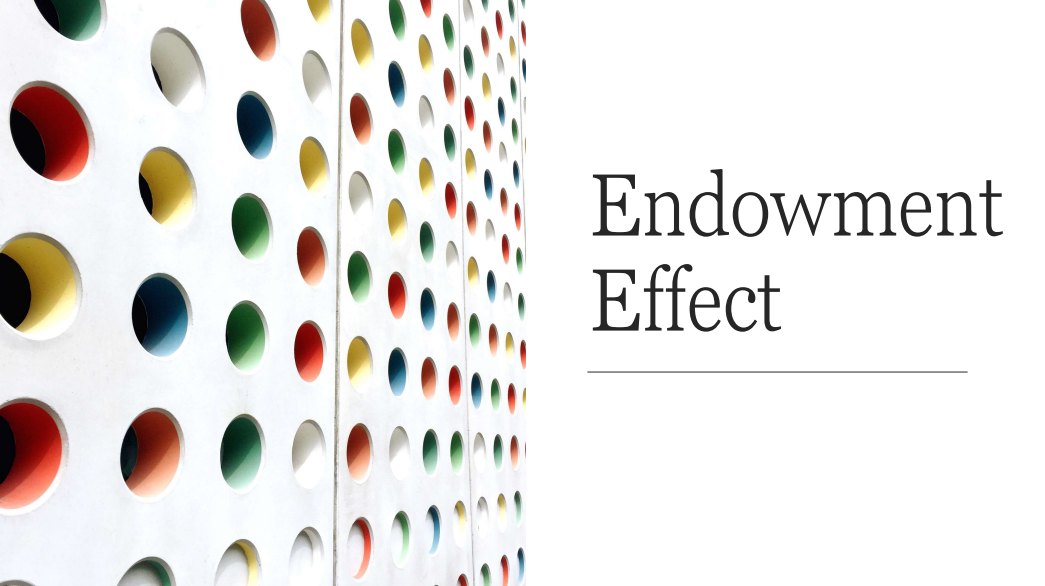Endowment Effect – The Tendency to Prefer What We Already Own
April 29, 2022

Written by: Aaron Simpson | April 29, 2022
Once investors conquer the hurdle of saving versus spending as I discussed in my previous behavioral finance article “Delayed Gratification,” they are then faced with the challenge of overcoming certain biases that can often hinder their long-term success. The behavioral bias I see affecting investment choices most at the beginning of a new client relationship is known as endowment effect. The tendency to prefer what we already own over any alternative that we don’t own, is endowment bias. Said another way – “What I already have is better than any other option that could be out there.”
Logically, we know that not to be true. However, in the world of finance, the emotional tie to your own money can create blinders to more efficient and possibly more profitable options.
In a now famous experiment, an economist gifted half of a group of Cornell students a coffee mug. He then asked those students how much they would charge to sell their new mug. Those gifted the mug said they would sell for an average of $4.50. The other half of the group who were not gifted a mug were asked how much they would be willing to pay for that same mug. The answer: $2.25.
The bias of mug ownership swayed the Cornell students into thinking the value of the mug was much higher than someone else would be willing to pay for it.
In another experiment, the whole class was given a mug, and a separate class was given a chocolate bar. At the end of the class, each individual was asked if they would trade their item for the other item. Only 10% of students said they would trade their chocolate bar for a mug or conversely, their mug for a chocolate bar. This speaks exactly to the endowment effect – thinking more favorably of what you own versus what the world thinks of its value.
Last example – two great clients of ours (whom I will not name) first came to us fresh off their retirement from General Electric five and a half years ago. Over 75% of their investable net worth was in GE stock when they arrived at our office for an initial consultation. I remember explicitly during the first discussion with them that while they acknowledged wanting planning assistance, they were adamant about keeping all the stock in their portfolio.
“We’ve worked at GE for 40 years. We have nothing but good things to say about the company.” I mentioned at the time that it is our job to present the recommendation that we feel is in a client’s best interest, even if they don’t “like” hearing the solution. During their planning process, we built two scenarios for them. In the first, they divested themselves from being so concentrated in GE over time, and the other appeased their feelings of endowment bias where no stock was sold.
Within six months of our new relationship, they gave us the approval to divest them entirely from GE.
Fast forward five years. GE stock has lost over 60% of its value at the time of this printing. Thankfully, these clients were able to overcome their endowment bias, be open to a new line of thinking and were able to lower their portfolio volatility and extend the life of their money. While their story has a happy ending, others may not be as fortunate.
Although there can be items which hold sentimental value to the owner that present a higher perceived cost, this very line of thinking can make investors miss out on market opportunities inside an investment portfolio. Whether I hold Apple stock or GE stock, gold shares or something else, it must be for a particular objective or goal that provides the investor with long-term benefits. If the ownership of the stock gets to the point where it doesn’t provide value any longer, it is time to explore a change.
The bias that prevents someone from making that change is known as loss aversion, which I will discuss during my next behavioral finance article.
Ready to Plant the Seeds for Your Retirement?
You only get to retire once, but we help people do it every day. Whether you’re just starting to plan or are nearing retirement, the small choices you make today can have a big impact on your tomorrow.
Connect with us to see how a true partnership can help your financial life take root and thrive.